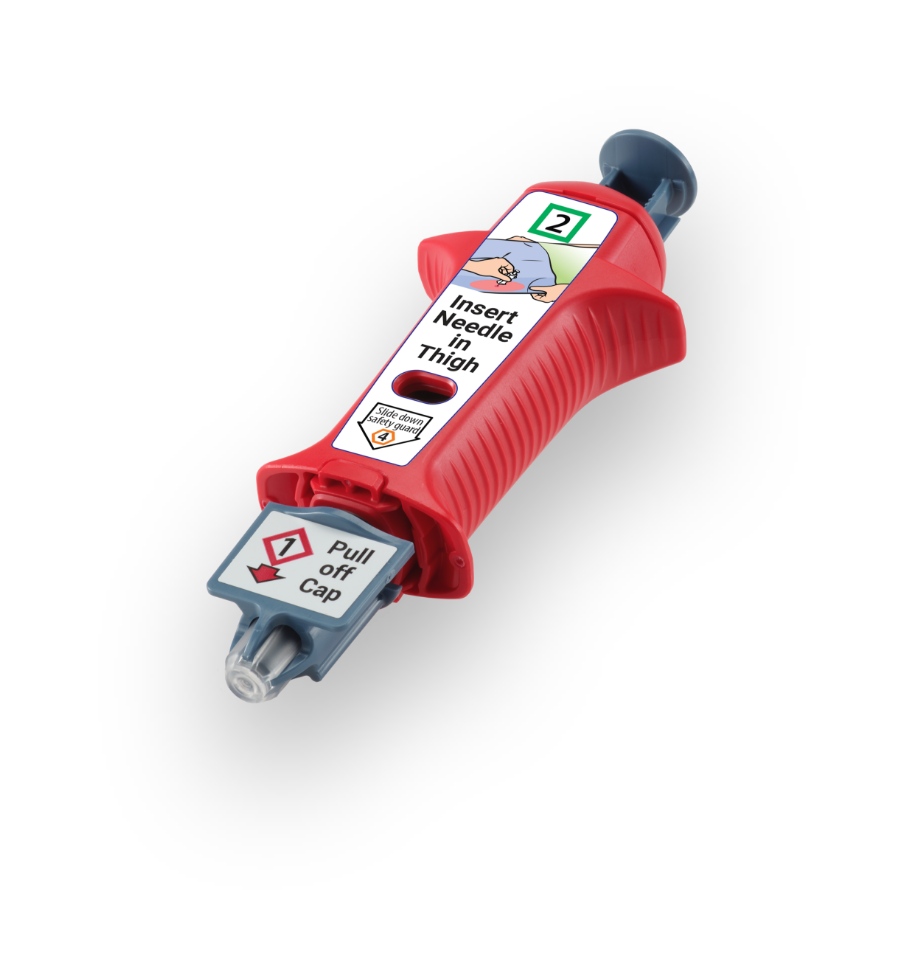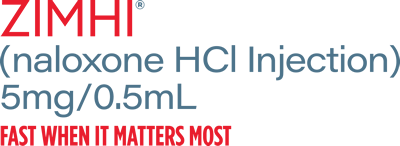HELPING PATIENTS UNDERSTAND THE NEED FOR NALOXONE
Patients being treated for opioid use disorder are at particularly high risk for overdose. For these patients and their family members, ASAM Guidelines recommend they be prescribed and trained to use naloxone.1
To overcome any concerns or negative reactions, there are several ways to counsel patients, including reminding them that 87% of all overdose deaths are accidental.2

HELPING PATIENTS UNDERSTAND THE NEED FOR NALOXONE

Some patients may feel offended by the suggestion of having naloxone to treat an opioid overdose. However, as you know, having a naloxone product, like ZIMHI, on hand can be the difference in an opioid overdose emergency rescue situation.
Patients being treated for opioid use disorder are at particularly high risk for overdose. For these patients and their family members, ASAM Guidelines recommend they be prescribed and trained to use naloxone.1
To overcome any concerns or negative reactions, there are several ways to counsel patients, including reminding them that 87% of all overdose deaths are accidental.2
“Are you saying I’m an addict?”
“An opioid emergency isn’t something people expect to happen. It’s also not something that only happens to people who are addicted to opioids. Almost 9 out of every 10 overdose deaths are accidental.2 Having ZIMHI within reach could help you be ready, no matter what.”
“I don’t need that.”
“While you may be very responsible and use opioids only as prescribed, it never hurts to have a safety plan. Plus, you never know when a child (even one who isn’t yours) could accidentally take your medication. Over 76,000 drug overdose deaths were due to opioids last year.3 Also, 87% of all drug overdoses are accidental.2 Naloxone has been shown to help reverse an overdose.4”
“I am only taking this oxycodone until my back pain goes away.”
“In our state (if applicable), whenever I prescribe an opioid to someone, I am required to prescribe a naloxone like ZIMHI.”
“If I see an opioid overdose emergency, I’ll just call 9-1-1 and they will help.”
“During an opioid emergency, using ZIMHI as soon as possible could make a big difference.5,6 If someone stops breathing during an overdose, brain damage can start in as soon as 1 or 2 minutes.7,8 After you use ZIMHI, you will still need to call 9-1-1 for emergency help as soon as possible.6”
“I’m just going to forget where I put it, or lose it anyway.”
“You should always have a safety plan in case of an opioid overdose emergency, which includes having ZIMHI in an easy-to-reach place. Also, make sure that anyone who may need to help during an opioid overdose emergency knows how to use ZIMHI and where you keep it.”
“I don’t even know what an opioid overdose emergency looks like or when to use ZIMHI.”
“The signs of an opioid overdose emergency may include pale, clammy skin; blue or purple fingernails; throwing up or making gurgling noises; not moving or appearing asleep; and/or being unable to speak.9 If you are caring for someone who you think may be experiencing an opioid overdose emergency, use ZIMHI as soon as possible and then call 9-1-1 for more help.6”
“I have been on and off opioids for a while. I know the ins and outs.”
“Your body doesn’t always react the same way to opioids, especially if you stop taking them for a while and then start again.10 Having ZIMHI can help you recover if you accidentally take more than your body is used to.”
“Should I be worried about opioid withdrawal after an overdose?”
“It’s going to be expensive. It’s not worth it.”
“In most cases, you can get ZIMHI at a low cost or for free, even without insurance. We can take a look together and figure out how much it will be.”
REVIEW THE 4 SIMPLE STEPS FOR USE
FAST ABSORPTION WITH ZIMHI
ORDER ZIMHI
In an opioid overdose emergency,
ZIMHI MAY MAKE ALL
THE DIFFERENCE
REQUEST A TRAINING DEVICE



In an opioid overdose emergency,
ZIMHI MAY
MAKE ALL THE
DIFFERENCE
REQUEST A TRAINING DEVICE



In an opioid overdose emergency,
ZIMHI MAY
MAKE ALL THE
DIFFERENCE
REQUEST A TRAINING DEVICE

References: 1. The ASAM national practice guideline for the treatment of opioid use disorder: 2020 focused update. J Addict Med. 2020;14(2S Suppl 1):1-91. doi:10.1097/ADM.0000000000000633 2. Hedegaard H, Miniño AM, Warner M. Drug overdose deaths in the United States, 1999-2018. NCHS Data Brief, No. 356. Hyattsville, MD: National Center for Health Statistics; 2020. 3. Centers for Disease Control and Prevention. Provisional drug overdose death counts. Updated October 13, 2021. Accessed November 7, 2021. https://www.cdc.gov/nchs/nvss/vsrr/drug-overdose-data.htm 4. Reverse overdose to prevent death. Centers for Disease Control and Prevention. Updated November 17, 2021. Accessed November 30, 2021. https://www.cdc.gov/drugoverdose/prevention/reverse-od.html 5. FDA Advisory Committee on the most appropriate dose or doses of naloxone to reverse the effects of life-threatening opioid overdose in the community settings. Adapt Pharma Operations Limited; 2016. 6. ZIMHI. Prescribing information. 7. Spinal Cord. How long can the brain go without oxygen? What happens? Published June 9, 2020. Accessed November 30, 2021. https://www.spinalcord.com/blog/what-happens-to-the-brain-after-a-lack-of-oxygen 8. Family Caregiver Alliance. Hypoxic-anoxic brain injury. Updated 2004. Accessed November 30, 2021. https://www.caregiver.org/hypoxic-anoxic-brain-injury 9. Medline Plus. Opioid overdose. Updated June 3, 2021. Accessed November 30, 2021. https://medlineplus.gov/opioidoverdose.html 10. Management of substance abuse: information sheet on opioid overdose. World Health Organization. Updated August 4, 2021. Accessed November 30, 2021. http://www.who.int/substance_abuse/information-sheet/en 11. Rzasa Lynn R, Galinkin J. Naloxone dosage for opioid reversal: current evidence and clinical implications. Ther Adv Drug Saf. 2018;9(1):63-88. doi:10.1177/2042098617744161
INDICATION
ZIMHI is an opioid antagonist indicated for the emergency treatment of known or suspected opioid overdose, as manifested by respiratory and/or central nervous system depression in adult and pediatric patients. ZIMHI is intended for immediate administration as emergency therapy in settings where opioids may be present. ZIMHI is not a substitute for emergency medical care.
IMPORTANT SAFETY INFORMATION
As the duration of action of naloxone hydrochloride is shorter than many opioids, keep the patient under continued surveillance and administer repeated doses of naloxone using a new ZIMHI device, as necessary, while awaiting emergency medical assistance.
Reversal of respiratory depression caused by partial agonists or mixed agonists/antagonists, such as buprenorphine and pentazocine may be incomplete. Repeat doses of ZIMHI may be required.
Use in patients who are opioid dependent may precipitate opioid withdrawal. In neonates, opioid withdrawal may be life-threatening if not recognized and properly treated. Monitor for the development of signs and symptoms of opioid withdrawal.
Abrupt postoperative reversal of opioid depression may result in adverse cardiovascular (CV) effects. These events have primarily occurred in patients who had pre-existing CV disorders or received other drugs that may have similar adverse CV effects. Monitor these patients closely in an appropriate healthcare setting after use of naloxone hydrochloride.
After use, the ZIMHI needle is exposed until the safety guard is deployed. A needlestick injury could occur during use in emergency situations. In the event of accidental needlestick injury, medical attention should be sought.
The following adverse reactions were most commonly observed in ZIMHI clinical studies: dizziness, lightheadedness, and elevated bilirubin.
To report SUSPECTED ADVERSE REACTIONS, call 1-800-230-3935 or FDA at
1-800-FDA-1088 or www.fda.gov/medwatch
IMPORTANT SAFETY INFORMATION and INDICATION for ZIMHI™
As the duration of action of naloxone hydrochloride is shorter than many opioids, keep the patient under continued surveillance and administer repeated doses of naloxone using a new ZIMHI device, as necessary, while awaiting emergency medical assistance.
Reversal of respiratory depression caused by partial agonists or mixed agonists/antagonists, such as buprenorphine and pentazocine may be incomplete. Repeat doses of ZIMHI may be required.
IMPORTANT SAFETY INFORMATION and INDICATION for ZIMHI™



